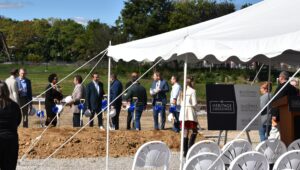There are plenty of steps before the finish line, but a Canadian company is hoping to erect a solar project in Lancaster County.
Toronto-based SolarBank Corp. is eyeing a 13.8-megawatt array that would take advantage of pending state legislation for so-called community solar programs.
The Lancaster project would be SolarBank’s first in Pennsylvania, according to Matt McGregor, the company’s senior director of business development.
“We’re really excited to be moving into Pennsylvania,” McGregor said in an interview with biznewsPA. “The market fundamentals and the coming community solar program are really promising for solar development in the state.”
Where is this happening: McGregor declined to share the exact location for now, saying only that the project would be on leased land in northwestern Lancaster County.
A key consideration in site selection was the capacity of local distribution lines, which connect to homes and businesses.
“That is always the biggest hurdle,” McGregor said, noting that a statewide analysis by SolarBank showed capacity in northwestern Lancaster.
Why is this happening: The potential establishment of community solar programs in Pennsylvania.
The programs are seen as a way to make solar power more directly available to households and businesses that can’t install panels on their roofs.
That includes people who live in condos and apartments, as well as small businesses that do not control their roof space.
They could pay to subscribe to a community solar program in return for savings on their electric bills.
In March, the state House narrowly passed legislation that would create a regulatory framework for the programs. But the bill has been sitting in a state Senate committee ever since.
“It’s not law yet,” McGregor acknowledged. “But in the last couple of years, developers are beginning to develop projects in Pennsylvania in anticipation of the bill being passed.”
While some utility-scale solar projects exceed 100 megawatts, projects for community solar programs are usually smaller.
The state legislation would limit them to five megawatts but raise the cap to 20 megawatts for projects built on brownfields.
A solar array typically requires about five acres per megawatt, according to McGregor.
What’s next: SolarBank is working with the local utility, PPL, to determine what it would cost to connect the Lancaster project to the local distribution system.
The analysis is expected to take about six to nine months, McGregor said.
SolarBank would then move into the local permitting process, at which point the location would become public.
It typically takes about 18 to 24 months before construction can start on a community solar project, McGregor said.
There also are plenty of variables that could affect the final size of the Lancaster array.
One is the final shape of state legislation, McGregor said. Another is the cost of connecting to the grid. The connection may require equipment upgrades.
“That’s what determines the financial feasibility of the project,” McGregor said.
SolarBank is considering two additional projects in Lancaster County, he added, describing them as “somewhat proximate” to the first project.
The background: SolarBank has undertaken more than a thousand industrial, commercial and community solar projects in Canada and the U.S. over the last decade.
The publicly traded company had revenue of $42.6 million in the year ending June 30, a 217% increase over the previous year.
It does business in the U.S. as Abundant Solar Power.
Solar, meanwhile, is among the fastest-growing energy sources in the U.S., according to the U.S. Energy Information Administration.
Pennsylvania is 21st among states in total solar capacity, and was 12th in adding capacity last year, according to the Solar Energy Industries Association. The Keystone state has 2,234 megawatts of solar power, representing 0.8% of the state’s electricity usage.








